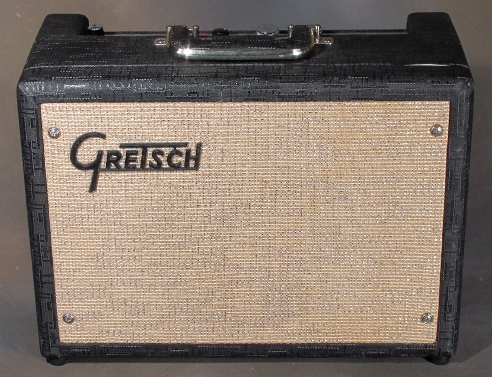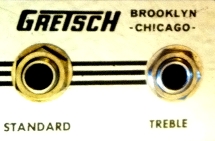

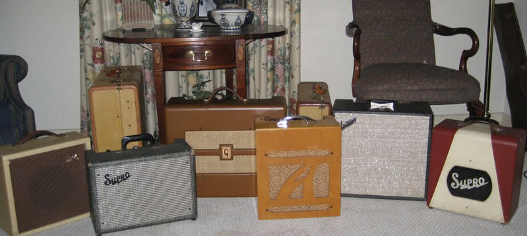
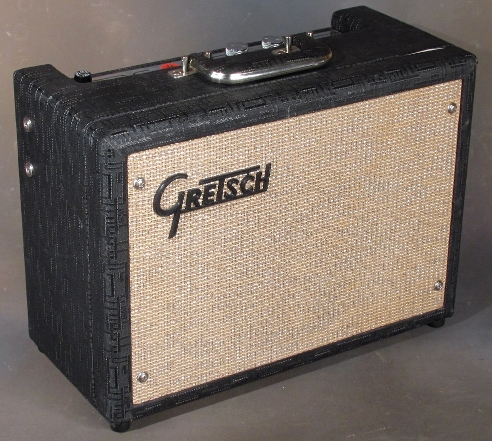
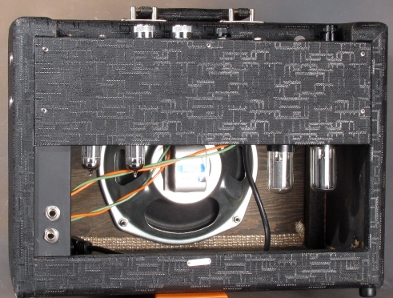 It sure looked that way to me from the pictures on the site. Four days later it arived, extremely well-packed and safe. After filling up the speaker cavity in the back with bubble wrap, the dealer had covered the speaker cloth and back opening with cardboard panels and floated the resultant sandwich in a sea of Styrofoam peanuts. I had a fifteen minute battle with the most highly static-charged packing peanuts I've ever encountered as I tried to remove the amp from the box. Folks, clumps of these peanuts literally leaped two feet out of the box to attach themselves to my hands, arms, and clothes. I couldn't shake or wipe them off because they would simply leap back onto me. I looked like a beekeeper covered with a swarm of white bees. Eventually I washed my hands and applied lotion and the packing peanuts relented.
It sure looked that way to me from the pictures on the site. Four days later it arived, extremely well-packed and safe. After filling up the speaker cavity in the back with bubble wrap, the dealer had covered the speaker cloth and back opening with cardboard panels and floated the resultant sandwich in a sea of Styrofoam peanuts. I had a fifteen minute battle with the most highly static-charged packing peanuts I've ever encountered as I tried to remove the amp from the box. Folks, clumps of these peanuts literally leaped two feet out of the box to attach themselves to my hands, arms, and clothes. I couldn't shake or wipe them off because they would simply leap back onto me. I looked like a beekeeper covered with a swarm of white bees. Eventually I washed my hands and applied lotion and the packing peanuts relented.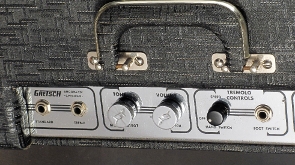 and a 12AX7 preamp tube give it plenty of power as a Class-A amplifier for the recording context and offers medium gain. The 6150T amp adds a second 12AX7 tube to operate the trem. On this example everything is solid and operates well. It doesn't appear to have quite the amount of gain found on the Supro in the clip, but with a booster on the front end can be made to sound very much like that one. You wouldn't expect a lot of bass out of an eight-inch speaker and there is no suprise here. However, the natural midrange emphasis of the amp makes it fit right into the electric guitar "space" in a mix readily. There's enough loudness available to excite a recording or iso room and get some early returns off the walls. The trem featured in this amp is of the “Bias Modulation” design where the bias current to the power tube is rhythmically modulated towards the negative causing the tube to repeatedly drop in output. The result is a very smooth, interesting tremolo that sounds quite different from the opto-isolator-based systems found on larger amps. This particular vintage implimentation is also unique in that it has no intensity control. I suppose we can chalk that up to the fact that this was an entry-level amp, huh? The trem is really pretty sounding but quite deep as well. I know there's a use for it, but I haven't worked that out quite yet.
and a 12AX7 preamp tube give it plenty of power as a Class-A amplifier for the recording context and offers medium gain. The 6150T amp adds a second 12AX7 tube to operate the trem. On this example everything is solid and operates well. It doesn't appear to have quite the amount of gain found on the Supro in the clip, but with a booster on the front end can be made to sound very much like that one. You wouldn't expect a lot of bass out of an eight-inch speaker and there is no suprise here. However, the natural midrange emphasis of the amp makes it fit right into the electric guitar "space" in a mix readily. There's enough loudness available to excite a recording or iso room and get some early returns off the walls. The trem featured in this amp is of the “Bias Modulation” design where the bias current to the power tube is rhythmically modulated towards the negative causing the tube to repeatedly drop in output. The result is a very smooth, interesting tremolo that sounds quite different from the opto-isolator-based systems found on larger amps. This particular vintage implimentation is also unique in that it has no intensity control. I suppose we can chalk that up to the fact that this was an entry-level amp, huh? The trem is really pretty sounding but quite deep as well. I know there's a use for it, but I haven't worked that out quite yet. I quickly picked up one lesson: The "Bright" input indeed gives you a brighter, cleaner sound but perhaps "thinner" is a better description because it offers lower gain than the "Standard" input as well. There's a fuller sound with quite a bit more gain in the "Standard" input. When you lean into the amp’s power, the rectifier sag and power tube distortion provide a lovely, springy compression that makes a guitar sing. When dimed, it also magically makes your pick attack go away, also probably a product of the tube rectifier and the saturation of the 6V6 power tube. I've played several guitars throught the amp and have found that the amp has a kind of a Voxy chime when you play a Strat through it, and a kind of mature, muscular vibe rather than a tinny one when you reach right below halfway on the volume. It's a really nice combination of glassy upper end and girth. When pushed on up it goes right into blues territory. When it is driven with humbuckers I can see why the original poster mic'd the amp from about eight feet away: as with most small class-A amps it has a certain "brattiness" that can most easily be smoothed out by moving the mic out from right up against the speaker cloth. By contrast, you get a feel for the amp’s native close sound when you listen to “Layla,” where the amps were close-mic’d. A Gibson with modern P-90 pickups seems to drive this little amp just right into singing sustain while reducing the brattiness.
I quickly picked up one lesson: The "Bright" input indeed gives you a brighter, cleaner sound but perhaps "thinner" is a better description because it offers lower gain than the "Standard" input as well. There's a fuller sound with quite a bit more gain in the "Standard" input. When you lean into the amp’s power, the rectifier sag and power tube distortion provide a lovely, springy compression that makes a guitar sing. When dimed, it also magically makes your pick attack go away, also probably a product of the tube rectifier and the saturation of the 6V6 power tube. I've played several guitars throught the amp and have found that the amp has a kind of a Voxy chime when you play a Strat through it, and a kind of mature, muscular vibe rather than a tinny one when you reach right below halfway on the volume. It's a really nice combination of glassy upper end and girth. When pushed on up it goes right into blues territory. When it is driven with humbuckers I can see why the original poster mic'd the amp from about eight feet away: as with most small class-A amps it has a certain "brattiness" that can most easily be smoothed out by moving the mic out from right up against the speaker cloth. By contrast, you get a feel for the amp’s native close sound when you listen to “Layla,” where the amps were close-mic’d. A Gibson with modern P-90 pickups seems to drive this little amp just right into singing sustain while reducing the brattiness.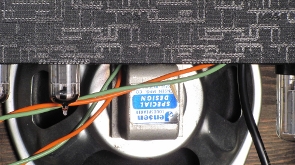 This is also an amp that changes character in an interesting way as you raise the volume. It starts with a bright, clean sound up through about halfway and then the sound smoothly transforms itself into a more rounded, midrangey honk at the top of its gain. This is perfect for moderating the insect-attracting overtones of the distorted tones. The base level Supro Super and Gretsch 6150 Compact have only a volume control and this little circuit design feature plays well to that. However, besides the tremolo, this 6150T model adds a tone control which is attractive for compulsive knob twiddlers like me. Whatever, this continuous transformation of the amp based upon the setting of the volume control means you have a wide variety of tones available at your fingertips even without touching the tone control. The amp also responds well to backing off the volume control on the guitar, cleaning up nicely when pulled down a couple of clicks. The little eight-inch Jensen Special Design speaker conveys the sound of the amp well and adds its own character to the mix. I should mention that the amp loves to have its front end "cooked." Cooking the front-end consists simply of pushing the front-end with a clean boost until it brightens up and blooms. The result is a very pretty and full sound with the amp run about half-way up. Adding in a good compressor can also add to the effect.
This is also an amp that changes character in an interesting way as you raise the volume. It starts with a bright, clean sound up through about halfway and then the sound smoothly transforms itself into a more rounded, midrangey honk at the top of its gain. This is perfect for moderating the insect-attracting overtones of the distorted tones. The base level Supro Super and Gretsch 6150 Compact have only a volume control and this little circuit design feature plays well to that. However, besides the tremolo, this 6150T model adds a tone control which is attractive for compulsive knob twiddlers like me. Whatever, this continuous transformation of the amp based upon the setting of the volume control means you have a wide variety of tones available at your fingertips even without touching the tone control. The amp also responds well to backing off the volume control on the guitar, cleaning up nicely when pulled down a couple of clicks. The little eight-inch Jensen Special Design speaker conveys the sound of the amp well and adds its own character to the mix. I should mention that the amp loves to have its front end "cooked." Cooking the front-end consists simply of pushing the front-end with a clean boost until it brightens up and blooms. The result is a very pretty and full sound with the amp run about half-way up. Adding in a good compressor can also add to the effect.